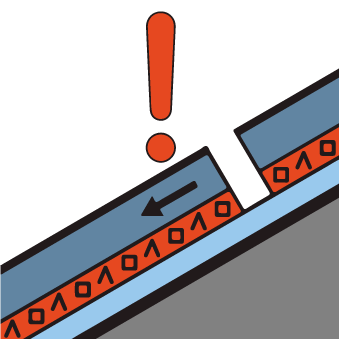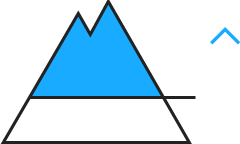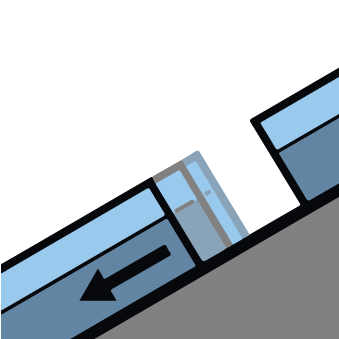
Danger level
 | 1900m
|
Avalanche Problem
 | | Persistent weak layer |
|  | |  |
 | | Wind-drifted snow |
|  | |  |

A precarious avalanche situation will be encountered in some regions.
The snow sport conditions outside marked and open pistes between approximately 1900 and 2300 m are precarious. Even single winter sport participants can release avalanches. This applies in particular in areas where the snow cover is rather shallow, as well as at transitions from a shallow to a deep snowpack. Avalanches can penetrate deep layers and reach dangerously large size. Remotely triggered avalanches are possible.
In addition the extensive wind slabs of the last few days in particular at high altitudes and in high Alpine regions are prone to triggering in some cases still. The prevalence of avalanche prone locations and likelihood of triggering will increase with altitude.
The danger of gliding avalanches will persist. Areas with glide cracks are to be avoided as far as possible. Extensive experience in the assessment of avalanche danger and great restraint are required.
Snowpack
dp.7: snow-poor zones in snow-rich surrounding
dp.2: gliding snow
Above approximately 1200 m snow will fall in particular in the west and in the north. In some regions 20 to 30 cm of snow will fall. This applies in particular in the west and in the northwest. The wind will be moderate to strong.
Avalanche prone weak layers exist in the centre of the snowpack. This applies in particular between approximately 1900 and 2300 m in all aspects. Towards its base, the snowpack is faceted.
The wind slabs of the last few days are lying on soft layers, especially at high altitudes and in high Alpine regions.
The snowpack will be moist at low and intermediate altitudes.
Tendency
The conditions remain precarious.

Danger level
 | 1700m
|
Avalanche Problem
 | | Persistent weak layer |
|  | |  |
 | | Wind-drifted snow |
|  | |  |

A precarious avalanche situation will be encountered in some regions.
The snow sport conditions outside marked and open pistes above approximately 1700 m are precarious. Even single winter sport participants can release avalanches as before. This applies in particular in areas where the snow cover is rather shallow, as well as at transitions from a shallow to a deep snowpack. Avalanches can penetrate deep layers and reach dangerously large size. Remotely triggered avalanches are possible.
In addition the wind slabs of the last few days in particular at high altitudes and in high Alpine regions are prone to triggering in some cases still. The prevalence of avalanche prone locations and likelihood of triggering will increase with altitude.
The danger of gliding avalanches will persist. Areas with glide cracks are to be avoided as far as possible. Extensive experience in the assessment of avalanche danger and great restraint are required.
Snowpack
dp.7: snow-poor zones in snow-rich surrounding
dp.2: gliding snow
Some snow will fall. The wind will be moderate to strong.
The wind slabs of the last few days are lying on soft layers. This applies at high altitude. Avalanche prone weak layers exist in the centre of the snowpack. Towards its base, the snowpack is faceted. The snowpack will be moist at low and intermediate altitudes.
Tendency
The conditions remain precarious.

Danger level
 | 2000m
|
Avalanche Problem
 | | Persistent weak layer |
|  | |  |
 | | Gliding snow |
|  | |  |

Weak layers in the old snowpack necessitate caution. Gliding avalanches are still possible.
Caution is to be exercised in all aspects above approximately 2000 m. Avalanches can be triggered in the weakly bonded old snow, this applies even in case of a single winter sport participant. Caution is to be exercised in particular on very steep slopes, as well as at transitions from a shallow to a deep snowpack. The prevalence of avalanche prone locations and likelihood of triggering will increase with altitude. Avalanches can in isolated cases reach quite a large size.
As a consequence of the solar radiation, the likelihood of moist avalanches being released will increase. In the regions with a lot of snow more gliding avalanches are possible, even large ones in isolated cases, this also applies on shady slopes.
Extensive experience in the assessment of avalanche danger is required.
Snowpack
dp.2: gliding snow
The somewhat older wind slabs of the weekend have bonded quite well with the old snowpack. Avalanche prone weak layers exist in the centre of the snowpack. Towards its base, the snowpack is largely stable.
The snowpack will be moist at low and intermediate altitudes. The weather conditions will give rise to gradual consolidation of the snowpack.
Tendency
The danger of gliding avalanches and moist snow slides will persist. As a consequence of the sometimes strong westerly wind there will be only a slight increase in the danger of dry avalanches.













